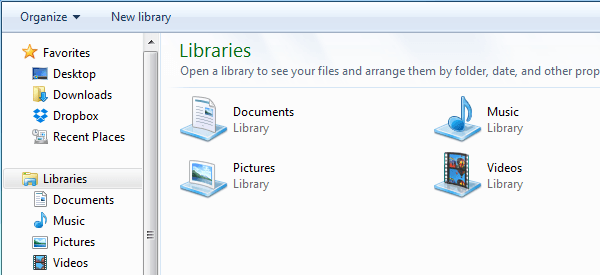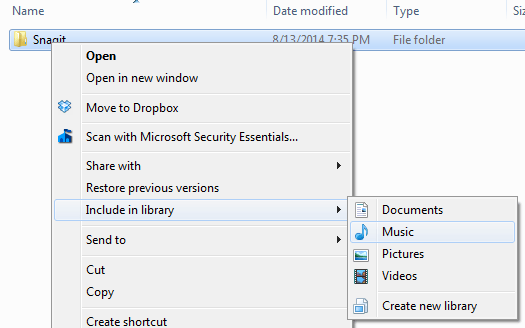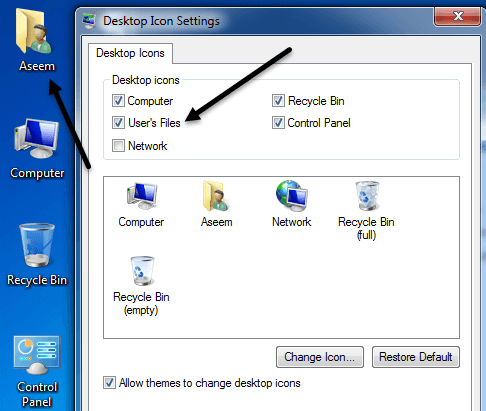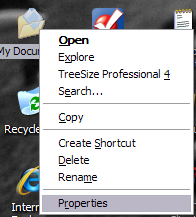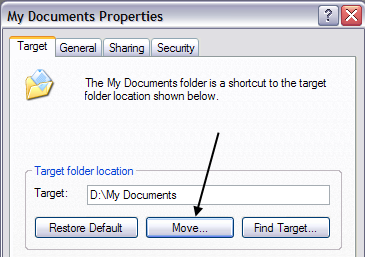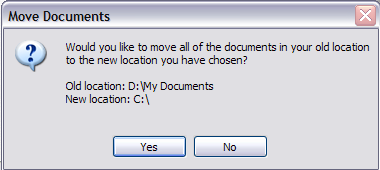How to Move or Change the Location of My Documents Folder
You should do this is you have more than one drive
By default, the My Documents folder is located in Windows XP and Windows Vista is located on the same drive or partition as the operating system. This is fine for anyone who has only a single drive or a single partition on their computers, such as the C drive, but if you have more than one physical or logical drive on your computer, it’s best to move your My Documents folder off the system drive.
In Windows 7 and Windows 8.1, the situation is a bit different. In Windows 7, you have libraries, which are kind of virtual folders that basically link to other folders that can be located anywhere. Also, starting in Windows 7, in addition to the My Documents folder, you also have the My Pictures, My Music, My Videos and Downloads folders. In Windows 8, the names got changed to simply Documents, Pictures, Music, Videos and Downloads.
That means in Windows 7/8.1, you have to manually change the location for each of these system folders if you want to move them. In Windows XP, all the other folders were inside the My Documents folder. I prefer the setup in Windows 7/8.1 because I normally don’t need to move all of the system folders, just one or two.
So you might be asking why I would be recommending this? Here are the main two reasons I’ve moved the My Documents folder:
1. Free up precious hard drive space on the system partition – With all of the monthly updates for Office and Windows, my C drive was getting close to becoming full! Also, other system files like the paging file, system restore files, and hibernation files are all stored on the system partition. Once I moved the data off, I gave space-hogging Windows more space to live and breathe.
2. Easy backup and recovery of data in case of Windows crash – The best reason to move the My Documents folder is to better help protect your data. For example, if Windows crashes on you one day and you have to perform a reinstall, then all of your data will be lost if you didn’t have a backup. However, if your data is on the D drive, let’s say, and your Windows partition craps out, you can reinstall a fresh copy of Windows on the C drive and the rest of your data remains intact!
Of course, this will not save your data if the entire hard drive fails physically and your My Documents folder is on the same drive, just in a different partition, but there have been many occasions in my time when Windows has become unusable due to a virus, spyware or other calamity of sorts.
Using Libraries in Windows 7/8.1
Before we get into the actual steps for moving the different system folders in Windows, let’s talk about libraries as they are a pretty good solution for most people. Instead of physically moving the system folders to another location, you can simply move your data to wherever you like and then add that folder to one of the special libraries: Documents, Music, Pictures, Video.
To add a folder to a library, just go to the folder you want to add, right-click on it, choose Include in library and then pick the library you want to add the folder to.
This does not copy or move the contents of that folder to the library, it simply creates a shortcut to the folder, but it won’t look like a shortcut. It’ll seem as if the folder is actually located in that folder, where in reality it could be on a totally different disk.
You can even include folders in network locations in a library, but you first have to make it available offline. To do that, just right-click on the folder and choose Always available offline. Once it has synced the folder to your local computer, you can right-click again and you will see the Include in library option.
In Windows 8.1, Microsoft suddenly hid the libraries feature for no apparent reason, even though it still exists. So instead of seeing Libraries in the left-hand menu in Explorer, you’ll see This PC with links to the system folders (Documents, Pictures, etc).
To get libraries back in Windows 8.1, click on the View tab and then click Navigation Pane. Then click the checkbox next to Show Libraries.
As I mentioned earlier, using libraries is a good alternative in case you don’t want to move a lot of data around from their current locations.
Move My Documents in Windows 7/8.1
The process for moving the system folders in Windows 7/8.1 is the same for both operating systems. In Windows 7, you have to click on your user folder on the desktop or navigate to C:\Users\UserName to see the system folders. If you don’t see the user folder on your desktop, right-click on the desktop, choose Personalize and then click on Change Desktop Icons. There you can check the User’s Files box.
As mentioned above, in Windows 8.1, just click on This PC on the left-hand menu and you’ll see the system folders. Then right-click on the folder you want to move and choose Properties.
Click on the Location tab and then click on the Move button. Choose a destination for the folder and Windows will begin to move everything over to the new location.
Move My Documents Folder in Windows XP
In Windows XP, the process is very similar as above, but you only have to do it for one folder instead of several folders. Right-click on the My Documents folder on your desktop and choose Properties.
2. Click Move and choose the desired location for your My Documents folder. Remember, it would be best to move it to a different PHYSICAL drive if possible. If not, move it to a different partition at least.
3. Click Ok and then click Apply. You’ll be asked whether you want to move all of the current documents to the new location or not. Choose Yes.
And that’s it! Your documents will be moved to the new location and when you click the My Documents icon on your desktop, it’ll open just as before. If you have any questions, post a comment. Enjoy!
Founder of Online Tech Tips and managing editor. He began blogging in 2007 and quit his job in 2010 to blog full-time. He has over 15 years of industry experience in IT and holds several technical certifications. Read Aseem’s Full Bio
Changing the default installation folder for programs in Windows 10 — safely
Having recently installed Windows 10 after my incredible XP Pro server died suddenly, I have immediately managed to break it by changing the default installation folder for programs through Regedit.
I did this following input I found online; when, I must admit, I entirely ignored the warning that currently installed programs may no longer work. That turned out to very true. Win10 loaded alright, but many actions produced no result whatever, not even an error message. Could not repair it either, and eventually I had to resort to a Linux-based tool (PMagic, if you must know — very cool stuff).
The solution suggested in the initial input was to move all currently installed files and folders to the new location.
I have been a believer in multiple partitions and physical disk drives for a very long time (and I always have several). I do not subscribe to the Microsoft approach, which puts everything into the C:\ installation partition — unless you tell it otherwise.
Unfortunately, some programs will not prompt for an installation path of choice. Thus my efforts in the Registry.
And this, therefor, is what I put to the community:
- Is there an official, Microsoft approved method of changing the default installation path for all user installed programs?
- If not, would it indeed be safe to change all relevant keys referring to ProgramFilsDir in the Registry and then simply and at the same time also move all material from the C:\Programs folder into a partition on another drive (entering the target location, in my case simply F:\ into the registry keys?
- Having thought about this for some time, I wonder: would it in fact work if I simply substituted (ie put into C:\ a shortcut named Programs, and have the shortcut point to my preferred location of F:\
And if you need to know: F: stands for Foftware, since S: I use for Source of programs. But funny bits aside, I am serious about my intentions and would really appreciate some knowledgeable input.
Greetings from down under
Replies (11)
* Please try a lower page number.
* Please enter only numbers.
* Please try a lower page number.
* Please enter only numbers.
Thank you for posting in Microsoft Community.
To change the default installation path, just follow below steps:
1. Press Windows key + R and type gpedit.msc
1. Navigate to HKEY_LOCAL_MACHINE\SOFTWARE\Microsoft\Windows\CurrentVersion.
2. At the right panel, look for ProgramFilesDir.
3. Double click on it to change the value to your desired path. For example, change the value from C:\Program Files to D:\Softwares.
Registry disclaimer
To do so: Important this section, method, or task contains steps that tell you how to modify the registry. However, serious problems might occur if you modify the registry incorrectly. Therefore, make sure that you follow these steps carefully. For added protection, back up the registry before you modify it. Then, you can restore the registry if a problem occurs. For more information about how to back up and restore the registry, click the following article number to view the article in the Microsoft Knowledge Base:
How to back up and restore the registry in Windows
Let us know the status of the issue.
5 people found this reply helpful
Was this reply helpful?
Sorry this didn’t help.
Great! Thanks for your feedback.
How satisfied are you with this reply?
Thanks for your feedback, it helps us improve the site.
How satisfied are you with this reply?
Thanks for your feedback.
Is there an official, Microsoft approved method of changing the default installation path for all user installed programs?
No.
If not, would it indeed be safe to change all relevant keys etc. etc.
Only if you want to trash your install.
Having thought about this for some time, I wonder: would it in fact work if I simply substituted (ie put into C:\ a shortcut named Programs, and have the shortcut point to my preferred location of F:\
See above answer.
You seem intent on making the operating system work in a way it was never designed to work. You must have the coolest automobile, but I wouldn’t want to drive it.
2 people found this reply helpful
Was this reply helpful?
Sorry this didn’t help.
Great! Thanks for your feedback.
How satisfied are you with this reply?
Thanks for your feedback, it helps us improve the site.
How satisfied are you with this reply?
Thanks for your feedback.
Thank you for your input, all parts of which are fair enough. And, yes, maybe I am intent on that, but just maybe the OS could offer more options. And I do drive the coolest car.
But seriously, I am thinking that there is speed to be gained by having the OS on one drive; and have it load programs from another. And this is the basis for my efforts; which I will now abort anyway.
2 people found this reply helpful
Was this reply helpful?
Sorry this didn’t help.
Great! Thanks for your feedback.
How satisfied are you with this reply?
Thanks for your feedback, it helps us improve the site.
How satisfied are you with this reply?
Thanks for your feedback.
Thank you for responding. I will need to think about doing it again this way (if at all). I had followed this lead: http://www.groovypost.com/howto/modify-windows-default-program-install-directory/ which referrs to two keys and adds detail for 64-bit systems — which mine is.
I boldly changed all and stuffed it up big time as I said in my post.
If I follow your lead precisely, can I assume that the Windows programs continue to work, while having my installs go to the new path? In my earlier efforts I could not even open the registry editor anymore; so could not fix the issue. And attempting to Repair from the installation medium also failed.
Was this reply helpful?
Sorry this didn’t help.
Great! Thanks for your feedback.
How satisfied are you with this reply?
Thanks for your feedback, it helps us improve the site.
How satisfied are you with this reply?
Thanks for your feedback.
Given the speed of today’s hardware, I don’t think it would make any difference performance-wise if you tried to install applications on a different partition.
No matter where you install them, applications write to the registry, which is always located on the system partition. Applications also install files onto the system partition and reference libraries on the system partition. Applications and the OS are deeply linked so it makes no sense to separate them. It’s like making newlyweds sleep on separate beds.
If you want to separate your data from your software, that’s a fabulous idea. Windows makes it easy to do that. And it makes sense, because if you need to restore a backup of your OS why send your personal folders back in time, and vice versa?
Was this reply helpful?
Sorry this didn’t help.
Great! Thanks for your feedback.
How satisfied are you with this reply?
Thanks for your feedback, it helps us improve the site.
How satisfied are you with this reply?
Thanks for your feedback.
I have similar questions. Not sure how to get around it yet.
As part of justification for 3 partition setup.
Microsoft has been notorious for having its own updates, or other softwares and their updates, mess up many times.
Also, some executables turn out to be viruses, bcs MS is so inept at making and keeping a secure OS, as they have even given up on MS essentials and really want people to go get other companies’ antivirus.
jBut the main thing is running C drive on an SSD, esp if only 64gb which used to be plenty big but now is too small, and soon enough even 128 gb will be too small bcs of all the MS bloat!
So having just the OS on the ssd, and then putting your added programs on a spinning hard drive partition and your data drive on another spinning hard drive partition, is the MAIN reason that people need this setup!
On win xp and win 7, i have always run 3 partitions, and using the junctions and rededit minor changes for drive letters.
My config is C, E, G — C for win os of course, E for executables, and G for garage (ie, personal data, stuffed like everyone’s house garages with all my stuff, my keepsakes, etc.
As an additional benefit, my disk drive i always make D (like, duh!), and then my sd slot and photo card I relettered to F for Fotos.
Thus, i have a c,d,e,f,g that covers all my computer needs. and then use 2 tb external hard drives M for multimedia (music, pics), and another for N for nickelodeon (ie my movies/films/vids). If I get to the point of needing a pix only xhd, then of course P will come in handy.
In any case, when Windows messes up and have to do reinstall at some point. then I only have to reinstall first the os on C, and leave E and G alone.
I’ll have to reinstall programs from E, but the point is that all the exe and setup files are there on my E, and preserved, so i just start dblclicking their file names to get them reinstalled.
I dont have to remember what programs I had, or what I might have lost (ie some software like DVD shrink or mgi photosuite for win 7 no longer seem to exist and impossible to re-obtain).
The fact that I like to redirect my Program Files and Program Files (x86) to my E drive is also to help protect all 3. if something nasty gets in (which it hasnt sincce Ive been careful), I believe it less likely that it will run amok my whole system. at least it would have a much smaller play area, ie only the E drive, where it might do stuff.
BUT the main reason is bcs of using an SSD for the C os drive!
In any case, the drive letters should NOT matter to microsoft.
Particularly since it has always worked on their systems, and there are innumerable posts and websites of how to do these steps in XP and 7 bcs some people just want to.
It is my computer and *I* should have some say in where things go, as I have an entire system, as many others do, so that I can find my stuff, and protect myself.
It just gets irritating that microsoft, who can’t ever manage to put out any product without bugs, fixes, or new breakings of other things.
thinks that it knows better than me about what i want.
